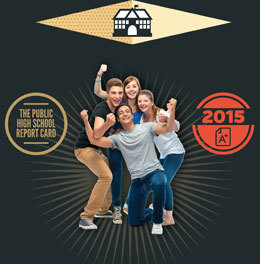
Kids at the bus stop, teachers prepping lesson plans, lockers stuffed with books, athletic teams hitting the practice field. It can only mean one thing: The return of the school year is upon us. But how much do you really know about your child’s school and its approach to academics? In South Jersey there are numerous high schools that not only prepare students for the upcoming test, but also for college and beyond. Using information from the New Jersey Department of Education School Performance Reports, we’ve ranked every public high school in Burlington, Camden and Gloucester counties in categories like average SAT scores, student-to-teacher ratio, graduation rates and more. We’ve also talked to local parents, teachers and administrators about the issue of PARCC testing in schools. It’s been a hot topic of conversation as it makes its return this school year, though with promised changes that aim to smooth over some of the frustration. Here, then, are your study materials.
Average SAT Score
Haddonfield Memorial High School: 1768
Cherry Hill High School East: 1718
Moorestown High School: 1706
Eastern High School: 1658
Shawnee High School: 1623
Cherokee High School: 1582
Cherry Hill High School West: 1578
Lenape High School: 1575
Seneca High School: 1574
Clearview Regional High School: 1533
Kingsway Regional High School: 1527
Cinnaminson High School: 1525
Rancocas Valley Regional High School: 1522
Washington Township High School: 1515
Haddon Township High School: 1514
Northern Burlington County Regional High School: 1500
West Deptford High School: 1493
Haddon Heights Junior/Senior High School: 1487
Bordentown Regional High School: 1486
Audubon Junior/Senior High School: 1485
Triton High School: 1477
Timber Creek High School: 1475
Collingswood Senior High School: 1466
Deptford Township High School: 1463
Delran High School: 1454
Highland Regional High School: 1453
Williamstown High School: 1446
Gateway Regional High School: 1442
Florence Township Memorial High School: 1437
Burlington Township High School: 1430
Sterling High School: 1429
Maple Shade High School: 1423
Delsea Regional High School: 1419
Riverside High School: 1414
Pemberton Township High School: 1413
Pitman High School: 1406
Woodbury Junior/Senior High School: 1400
Glassboro High School : 1383
Overbrook High School: 1347
Clayton High School: 1320
Burlington City High School: 1319
Winslow Township High School: 1314
Pennsauken High School: 1303
Palmyra High School: 1294
Lindenwold High School: 1287
Paulsboro High School : 1227
Willingboro High School: 1220
Woodrow Wilson High School: 1018
Camden High School: 1014
Graduation Rate %
Cinnaminson High School: 98
Shawnee High School: 98
Cherokee High School: 97
Burlington Township High School: 97
Haddonfield Memorial High School: 96
Moorestown High School: 96
Seneca High School: 96
Lenape High School: 96
Cherry Hill High School East: 95
Eastern High School: 95
Clearview Regional High School: 95
Kingsway Regional High School: 95
Northern Burlington County Regional High School: 95
Pitman High School: 95
Washington Township High School: 94
Delran High School: 93
Glassboro High School : 92
Audubon Junior/Senior High School: 92
Sterling High School: 92
Maple Shade High School: 92
Haddon Township High School: 91
West Deptford High School: 91
Bordentown Regional High School: 91
Timber Creek High School: 91
Delsea Regional High School: 91
Rancocas Valley Regional High School: 91
Cherry Hill High School West: 89
Highland Regional High School: 89
Riverside High School: 89
Williamstown High School: 87
Florence Township Memorial High School: 87
Gateway Regional High School: 86
Haddon Heights Junior/Senior High School: 86
Woodbury Junior/Senior High School: 86
Deptford Township High School: 85
Overbrook High School: 85
Triton High School: 84
Pemberton Township High School: 84
Paulsboro High School : 84
Clayton High School: 83
Collingswood Senior High School: 83
Palmyra High School: 82
Burlington City High School: 82
Winslow Township High School: 81
Lindenwold High School: 78
Pennsauken High School: 75
Willingboro High School: 74
Woodrow Wilson High School: 60
Camden High School: 52
A.P. Classes
High School; A.P. classes offered; # of students taking
Cherry Hill High School East; 21; 990
Washington Township High School; 20; 805
Moorestown High School; 19; 746
Cherry Hill High School West; 19; 656
Haddonfield Memorial High School; 18; 500
Shawnee High School; 18; 569
Lenape High School; 17; 622
Eastern High School; 17; 662
Cherokee High School; 17; 573
Seneca High School; 17; 425
Clearview Regional High School; 16; 570
Woodbury Junior/Senior High School; 16; 258
N. Burlington County Regional HS; 15; 461
West Deptford High School; 13; 318
Rancocas Valley Regional HS; 13; 561
Timber Creek High School; 12; 395
Kingsway Regional High School; 11; 442
Cinnaminson High School; 11; 242
Winslow Township High School; 11; 183
Burlington Township High School; 11; 197
Williamstown High School; 10; 243
Triton High School; 10; 276
Delran High School; 10; 158
Pennsauken High School; 9; 194
Haddon Township High School; 9; 103
Highland Regional High School; 9; 311
Pemberton Township High School; 9; 97
Audubon Junior/Senior High School; 8; 95
Glassboro High School ; 8; 129
Collingswood Senior High School; 8; 100
Burlington City High School; 8; 63
Palmyra High School; 8; 29
Delsea Regional High School; 7; 147
Deptford Township High School; 7; 109
Bordentown Regional High School; 7; 116
Overbrook High School; 7; 127
Haddon Heights Junior/Senior; 6; 108
Gateway Regional High School; 6; 57
Pitman High School; 6; 69
Willingboro High School; 6; 59
Maple Shade High School; 6; 62
Lindenwold High School; 5; 92
Florence Township Memorial HS; 5; 53
Sterling High School; 5 ; 218
Clayton High School; 4; 91
Woodrow Wilson High School; 4; 37
Riverside High School; 3; 42
Paulsboro High School ; 2; 13
Camden High School; 0; 0
Student-to-Faculty Ratio
Paulsboro High School, 5:1
Haddonfield Memorial High School, 5:1
Gateway Regional High School, 6:1
Burlington City High School, 7:1
Pitman High School, 7:1
Palmyra High School, 8:1
Woodbury Junior/Senior High School, 8:1
Seneca High School, 8:1
Overbrook High School, 8:1
Riverside High School, 8:1
Clayton High School, 9:1
Cinnaminson High School, 9:1
Camden High School, 9:1
Haddon Heights Junior/Senior High School, 9:1
Audubon Junior/Senior High School, 9:1
Collingswood Senior High School, 9:1
Pemberton Township High School, 10:1
Lindenwold High School, 10:1
Deptford Township High School, 10:1
Cherokee High School, 10:1
Sterling High School, 10:1
Lenape High School, 10:1
Delran High School, 10:1
West Deptford High School 10:1
Glassboro High School , 11:1
Woodrow Wilson High School, 11:1
Winslow Township High School, 11:1
Kingsway Regional High School, 11:1
Washington Township High School, 11:1
Shawnee High School , 11:1
Pennsauken High School, 11:1
N. Burlington County Regional HS, 11:1
Burlington Township High School, 11:1
Clearview Regional High School, 11:1
Triton High School, 11:1
Moorestown High School, 12:1
Maple Shade High School, 12:1
Highland Regional High School, 12:1
Haddon Township High School, 12:1
Timber Creek High School, 12:1
Cherry Hill High School West, 13:1
Delsea Regional High School, 13:1
Williamstown High School, 13:1
Eastern High School, 13:1
Bordentown Regional High School, 14:1
Willingboro High School, 15:1
Florence Township Memorial High School, 15:1
Cherry Hill High School East, 16:1
Rancocas Valley Regional High School, 16:1
The Return of PARCC
The controversial testing returns this school year, but with changes.
Statewide assessments of student learning have long been a part of New Jersey’s school curriculum. In fact, the state has administered such exams since the 1970s. But the 2014-15 school year marked a new era of testing when New Jersey began participating in The Partnership for Assessment of Readiness for College and Careers (PARCC).
Students from 11 states, along with the District of Columbia, took the PARCC tests last year, which are “designed to provide schools with information to improve classroom instruction and give parents valuable feedback about their child’s progress,” says Michael Yaple, director of public information for the New Jersey Department of Education.
The PARCC assessments were administered electronically to students in grades 3 through 11 last year, replacing the traditional paper-and-pencil exams we’re all familiar with. The first administration of the assessments was fraught with controversy, with many for, and just as many against, the new tests.
“Unfortunately, as I think many districts experienced, we were one of the districts where a lot of families opted out of taking the tests,” says Washington Township High School Principal Joe Bollendorf. “Even though there was not technically an option, we did receive letters from families saying they did not want their children to take the test, and of course we followed up with a letter to them, but we had a good number of kids not take the tests.”
Though each family had their reasons for not wanting their children to take the tests, for one Medford Lakes School District parent, who did not wish to be named, the assessments represent “what’s getting progressively worse with our public education system.”
“Aside from the strange requirements and rules attached to the test, the fact that they don’t promote age-level learning and evaluation, won’t provide any usable results that will benefit the students in their ongoing education, and the fact that these tests are being used to evaluate teacher effectiveness make the PARCC not only a waste of time and taxpayer money, but also an actual detriment to real, valuable education,” she says, noting she kept her two children home during the assessments last year and plans to do so again this year. “After doing a tremendous amount of research, considering voices from both sides of the argument, it became very clear to me that the PARCC test is not at all about supporting positive, effective learning, but about political and economic issues that don’t have our children’s best interest in mind at all.”
Another parent, from the Mantua School District, who also did not want to be named, says though she had friends who also removed their children from school during the testing, she did not.
“I honestly don’t see what the big deal is over having this test,” she says. “My daughter was overwhelmed leading up to the test in that she was having stomachaches before school because the teachers kept stressing to them how important these tests were, but in talking to her afterwards each day, she would say she was nervous for no reason. I would ask her how long they took, did she finish, were they easy, etc., and I have no complaints whatsoever.
“In life we all work up to certain goals and standards,” she continues, “so I feel that if this testing truly provides insight on where my child is lacking in an area, then of course, it is necessary.”
Though test results to indicate how students did on the tests will not be available until this fall, there are already some changes being implemented to the tests after its initial implementation. “In an effort to be responsive to feedback from educators and parents, PARCC was shortened, and the two testing windows were collapsed into one,” says Yaple, who notes that schools will not be testing all days within a window, but would select days that work best for them.
This means schools will have 30 days to test, but most will complete the testing within a week or two, depending on how many devices they have available for students to test on. Testing times will also be cut by approximately 90 minutes. While there were certainly growing pains during the first year of the assessments, one Camden County teacher is optimistic year two will be better.
“As with any new thing that the state gives teachers, the first rollout is always terrible,” he says. “That’s just the way that it goes. Our first trial, a practice test, was utter chaos. The second time we actually did the test, it did work out a little better. … Overall, though, I thought it went better than I thought it would … and the second year is going to be that much easier. The first year is the not knowing, by not just the students, but the teachers themselves. But now that [the teachers] have a year under our belts, we know what they’re about, and we can make our tests more like the PARCC, so the students are prepared.”
Published (and copyrighted) in South Jersey Magazine, Volume 12, Issue 6 (September, 2015).
For more info on South Jersey Magazine, click here.
To subscribe to South Jersey Magazine, click here.
To advertise in South Jersey Magazine, click here.












